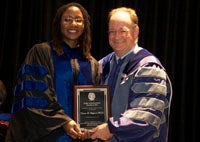Vanessa B. Sheppard: Righting a Deadly Imbalance

Posted in GUMC Stories
 Vanessa Sheppard, Ph.D., an assistant professor at Georgetown Lombardi Comprehensive Cancer Center, is a population scientist, a designation that conjures up visions of a life spent in the glow of the computer screen mining data and compiling statistics—not at all an accurate picture. The irony of population science is that it’s up close and personal: real progress comes from one-on-one encounters with real people. To learn why a certain cohort of patients stop taking medicine that will save their lives, and to then develop strategies that will correct that situation, you have to spend a lot of time with individuals, learn all you can about the many idiosyncratic as well as environmental factors that are at play, and test every conjecture that seeks to be a relevant piece of the puzzle.
Vanessa Sheppard, Ph.D., an assistant professor at Georgetown Lombardi Comprehensive Cancer Center, is a population scientist, a designation that conjures up visions of a life spent in the glow of the computer screen mining data and compiling statistics—not at all an accurate picture. The irony of population science is that it’s up close and personal: real progress comes from one-on-one encounters with real people. To learn why a certain cohort of patients stop taking medicine that will save their lives, and to then develop strategies that will correct that situation, you have to spend a lot of time with individuals, learn all you can about the many idiosyncratic as well as environmental factors that are at play, and test every conjecture that seeks to be a relevant piece of the puzzle.
Says Sheppard, “When I’m outside my office, out in the community making that connection with people, that can be so powerful.”
The research method Sheppard employs is called an intervention—an intimate, often prolonged, and highly emotional—yet scientific—encounter with people who are grappling with the daunting predicament of navigating a health care system that can seem arcane and bewildering. An intervention is a scientific reconnaissance mission into the thick of a problem, one in which investigators often have to put down their notebooks and roll up their sleeves to get people the help they need right then and there.
Sheppard tells the story of leading a focus group when a woman mentioned that she had a lump in her breast and what should she do about it. “I turned off the tape recorder and switched immediately from research to ‘how can we help this woman get the care that she needs?’”
Currently, Sheppard is working on two projects.
The first, funded by the National Cancer Institute (NCI), is aimed at understanding problems associated with long-term adherence to hormonal therapy in breast cancer patients.
“We’re excited to be working with two HMOs, Kaiser Permanente in Georgia and Henry Ford Health System in Detroit,” she says. “So we’re going to be recruiting newly diagnosed African-American women and white women and following them for 3 years to look at factors that are associated with women who stop therapy early versus those who continue on.” She points out that this is therapy that significantly reduces mortality for hormone receptive positive breast cancer. “So if you have that form of breast cancer you need to stay on therapy for five years, yet nationally over half quit therapy after 4 years.”
“So we want to find out why—what are the factors causing women to stop their treatment early—do those factors differ between white and black women, or are they similar—with the goal of developing future strategies to help women.”
The second project is called “Stepping Stones” (stones stands for “survivors taking on nutrition and exercise”). This study, being carried out in collaboration with Lucile Adams-Campbell, Ph.D., co-director of the Georgetown Initiative to Reduce Health Disparities, is also funded by NCI. This project is an intervention for African-American women who are overweight or obese and who are breast cancer survivors. Women in the program, maybe at higher risk of having a recurrence because they are overweight, come in and have a group session–led by an exercise physiologist and a nutritionist—about healthy eating and exercise. They are given pedometers, and they have personalized goals for exercise and nutrition. Then they receive phone calls from a survivor-coach “to help really put the pieces together and learn how to apply this on a daily basis.”
“This is a feasibility study,” says Sheppard. “We’re trying to find out what works, and how to keep them motivated.”
“I like the opportunity in some way to find a solution to a problem. I like to publish what we find out for the scientific community, and I like working on things that are relevant, things that we do that are focused on eliminating disparities. We’re working on something that’s attainable—each piece that we learn, how can they fit together to help make a difference.”
By Frank Reider, GUMC Communications
